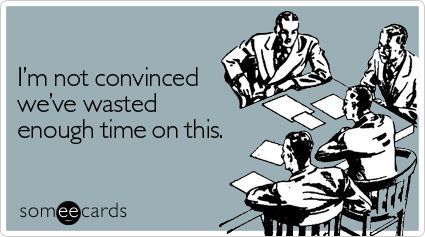
As part of the workshops that I deliver based on the Happy Healthy Nonprofit, one of my most popular is how to avoid collaborative overload in the nonprofit workplace. Collaborative overload results from too many pointless meetings, a tsunami of emails, and a drumbeat of constant interruptions.
These three things not only cause a lot of stress and can lead to burnout, but also end up costing a lot of money in wasted time and lost productivity. This infographic offers a great summary and breaks it down in dollars how much these time wasters cost us.
- Excessive Email: Whether you try to get to inbox zero or have 257,768 unanswered emails in your inbox, using email as a collaboration tool is not efficient. On average, according to research employees check their email 36 times per hour! It also takes 16 minutes to refocus after handling email. A constant flood of emails can lower your IQ by 10 points! The calculating the costs of this lost time can be more than $5,000 per employee.
- Meetings As Murder: Meetings that are not well designed or pointless are also huge productivity drains. According to research, 31 hours per week is spent on average in meetings per week and many of those meetings are considered unnecessary or pointless. $37 billion per year is wasted in unproductive meetings.
- Interruptions: Interruptions and distractions in the workplace can be major productivity bandits. According to research, there are 56 interruptions a day on average for employees. Even worse, 80% of interruptions are considered trivial. However, there is a counter argument (and research) that says in some cases distractions can increase creativity.
Sometimes, these time wasters are baked in the organizational culture and it becomes the norm. So, making change requires a dedicated focus on culture change, making small changes and doing it consistently. Here are some useful tips and processes to test to stop wasting time and a loss of productivity.
Tips
- Establish Stop Days or Blocking Out Solo Time for Focused Tasks
- Create Work Norms for Using Online Collaboration Tools
- Use Look Ahead Rituals To Anticipate Work Flow
- Create An Email Charter for Using Email Effectively
- Write Precise Emails
- Use Best Practices for Virtual Meetings
- Shift Fire Drill Culture
- Replace Status Update Meetings with Standing Meetings
- Schedule 30 minute meetings vs 60 minute meetings
- Create A Culture of Mindfulness
- Designate Quiet Spaces/Distraction Free Zones in Your Office
- Try a Walking Meeting
- Stop Using Email As A Collaboration Platform
What could your organization accomplish if that time was recovered and spent on mission-focused activities?

Leave a Reply